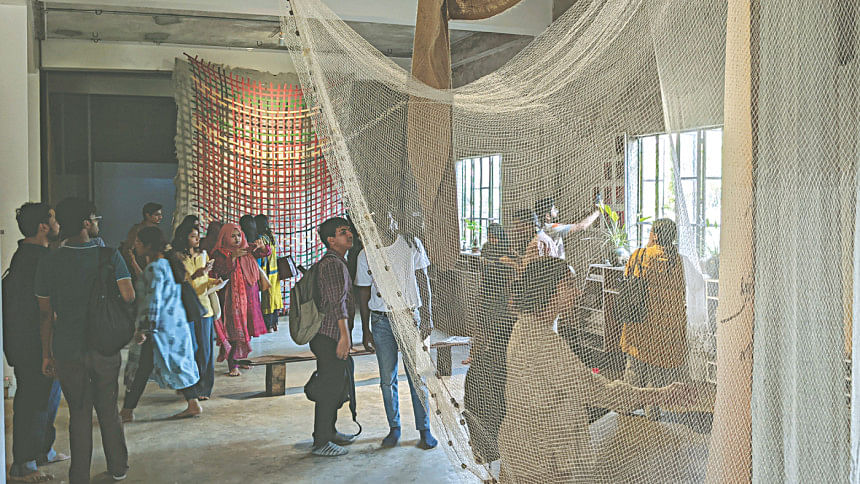Brihatta Paal: Moving through memories, myths, motion

Art studios and exhibitions are great storytellers. We often say that a picture is worth a thousand words. In that sense, any sort of visual art has a lot to say. Brihatta Art Foundation's exhibition, called "Paal", has that same essence.
Paal and Gangaburi
Gangaburi is a river heritage-focused art project that exhibits the rich heritage of the river Buriganga through artistic expressions. This project, named after Kafil Ahmed's song "Gangaburi", is curated and directed by Shehzad Chowdhury and Bishwajit Goswami, respectively. The landmark cultural initiative "Gangaburi" is reaching its conclusion after two years.
The British Council and the EUNIC (European Union National Institutes for Culture) Bangladesh Cluster jointly celebrate the completion of the project, and the project's culmination is being celebrated through a public exhibition at Brihatta Art Space, Hazaribagh, that was exhibited from April 25 to May 2.
"This journey has led me to reflect on the collectiveness amongst us -- where 'us' extends beyond people -- it encompasses the nature, the unseen forces, and elements shaping our existence," said Bishwajit Goswami, project director of Gangaburi.
The exhibition
Goswami said, "it is a symbol of movement, of journeys taken…. Land, water, and air -- three fundamental elements of existence -- come together through collaboration on creating the sails, reflecting the delicate balance between survival and spirituality, between nature and human intervention."
And the exhibition is an artistic expression of these words. There are three pieces, but intertwined within each of the pieces there are so many untold stories, and the way they represent our people's relationship with rivers, as well as the fundamental elements of existence, really implores one to look through the art. It's as if watching the pieces lend you a magical pair of glasses, through which you can visualise the untold stories.
The first sail conceptualises Bhumi (Land). Patches of fabrics sewn together, while forming a visual and tactile representation of Ail (ridges) and furrows of lands, where verses from Khona has been inscribed. Khona-r Bochon as they are known, has been part of our culture for as long as we can remember. The artwork reminds one of our farmlands from a bird's eye view. Perhaps, a more accurate description would be poet Jasimuddin's Nakshi Kanthar Math.
A parallel narrative on Jol (Water) unfurled on the second sail. Verses from folk poetry and music, and verses of the boatmen inscribed by urban traditional artists who reside near the Buriganga, became a part of the composition. Much like the "Gamchha", which is a woven everyday textile, this piece imbued with profound cultural implications through the weaving acts, where the act of weaving becomes an act of remembrance.
The last sail completes the dialogue by adding air to earth and water. Paban (Air) blends the themes through bold, expressive strokes. The installation of the sail structure, majorly reflected through the painting of Bishwajit Goswami transforms the physical form of the sail to become a vibrant testament to nature's expressions. There is a veil in front of the sail, which captures the fluidity of the river, the motion of the air -- weaving these elements into a visual narrative.

Brihatta itself
Of course, aside from the art pieces, the art space itself deserves its own recognition, given that it's an experience itself. Located in the heart of Hazaribagh, Dhaka, a place well known for tannery industries, an unexpected place for an art foundation, Brihatta uses all that to emphasise the point it is trying to make -- art is for everyone.
Once you are here, you become one of them, and Brihatta becomes yours. "To connect -- with others, nature, and ourselves -- is both an artistic pursuit and a human necessity," said Bishwajit Goswami, who invites everyone to Brihatta.
Maa, Mati, Manush, Bhasha, Swadesh, Prokriti -- these six words are inscribed on wall of the garden. That's right, Brihatta welcomes you with a rooftop garden. To pay tribute to the name of the locality -- Hazaribagh, meaning thousand gardens.

 For all latest news, follow The Daily Star's Google News channel.
For all latest news, follow The Daily Star's Google News channel. 



Comments